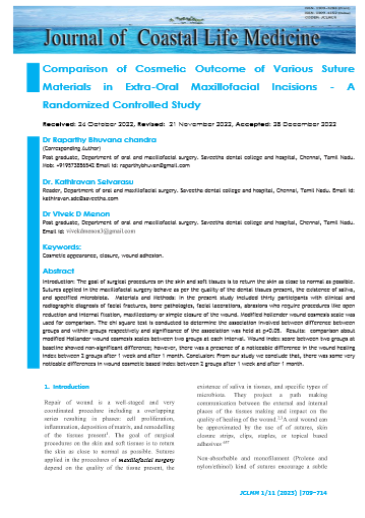Comparison of Cosmetic Outcome of Various Suture Materials in Extra-Oral Maxillofacial Incisions - A Randomized Controlled Study
Main Article Content
Abstract
Introduction: The goal of surgical procedures on the skin and soft tissues is to return the skin as close to normal as possible. Sutures applied in the maxillofacial surgery behave as per the quality of the dental tissues present, the existence of saliva, and specified microbiota. Materials and Methods: In the present study included thirty participants with clinical and radiographic diagnosis of facial fractures, bone pathologies, facial lacerations, abrasions who require procedures like open reduction and internal fixation, maxillectomy or simple closure of the wound. Modified hollender wound cosmesis scale was used for comparison. The chi square test is conducted to determine the association involved between difference between groups and within groups respectively and significance of the association was held at p<0.05. Results: comparison about modified Hollander wound cosmesis scales between two groups at each interval. Wound index score between two groups at baseline showed non-significant difference; however, there was a presence of a noticeable difference in the wound healing index between 2 groups after 1 week and after 1 month. Conclusion: From our study we conclude that, there was some very noticable differences in wound cosmetic based index between 2 groups after 1 week and after 1 month.
Article Details
References
Yilmaz, N., Inal, S., Muğlali, M., Güvenç, T. & Baş, B. Effects of polyglecaprone 25, silk and catgut suture materials on oral mucosa wound healing in diabetic rats: an evaluation of nitric oxide dynamics. Med. Oral Patol. Oral Cir. Bucal15, e526–30 (2010).
Soni, A. et al. Comparing Cyanoacrylate Tissue Adhesive and Conventional Subcuticular Skin Sutures for Maxillofacial Incisions—A Prospective Randomized Trial Considering Closure Time, Wound Morbidity, and Cosmetic Outcome. Journal of Oral and Maxillofacial Surgery vol. 71 2152.e1–2152.e8 Preprint at https://doi.org/10.1016/j.joms.2013.08.029 (2013).
Robson, M. C., Steed, D. L. & Franz, M. G. Wound healing: biologic features and approaches to maximize healing trajectories. Curr. Probl. Surg.38, 72–140 (2001).
Minozzi, F., Bollero, P., Unfer, V., Dolci, A. & Galli, M. The sutures in dentistry. Eur. Rev. Med. Pharmacol. Sci.13, 217–226 (2009).
Ratner, B. D., Hoffman, A. S., Schoen, F. J. & Lemons, J. E. Biomaterials Science: An Introduction to Materials in Medicine. (Academic Press, 2012).
Eaton, A. C. A controlled trial to evaluate and compare a sutureless skin closure technique (Op-Site Skin Closure) with conventional skin suturing and clipping in abdominal surgery. British Journal of Surgery vol. 67 857–860 Preprint at https://doi.org/10.1002/bjs.1800671207 (2005).
Banche, G. et al. Microbial Adherence on Various Intraoral Suture Materials in Patients Undergoing Dental Surgery. Journal of Oral and Maxillofacial Surgery vol. 65 1503–1507 Preprint at https://doi.org/10.1016/j.joms.2006.10.066 (2007).
Gennari, R. et al. A prospective, randomized, controlled clinical trial of tissue adhesive (2-octylcyanoacrylate) versus standard wound closure in breast surgery. Surgery vol. 136 593–599 Preprint at https://doi.org/10.1016/j.surg.2004.02.015 (2004).
Moy, R. L., Waldman, B. & Hein, D. W. A Review of Sutures and Suturing Techniques. The Journal of Dermatologic Surgery and Oncology vol. 18 785–795 Preprint at https://doi.org/10.1111/j.1524-4725.1992.tb03036.x (1992).
Bush, J. & Bayat, A. Surgical instruments, sutures and suturing techniques. British Journal of Hospital Medicine vol. 68 M142–M145 Preprint at https://doi.org/10.12968/hmed.2007.68.sup8.24511 (2007).
Chibbaro, S. & Tacconi, L. Use of skin glue versus traditional wound closure methods in brain surgery: A prospective, randomized, controlled study. J. Clin. Neurosci.16, 535–539 (2009).
Kang, H. Sample size determination and power analysis using the G*Power software. Journal of Educational Evaluation for Health Professions vol. 18 17 Preprint at https://doi.org/10.3352/jeehp.2021.18.17 (2021).
Hollander, J. E., Singer, A. J., Valentine, S. & Henry, M. C. Wound Registry: Development and Validation. Annals of Emergency Medicine vol. 25 675–684 Preprint at https://doi.org/10.1016/s0196-0644(95)70183-4 (1995).
FitzGibbon, G. M. The commandments of Gillies. Br. J. Plast. Surg.21, 226–239 (1968).

